Brand Management Report: Analysis of Coca-Cola's Brand Management
VerifiedAdded on 2020/06/04
|20
|6007
|26
Report
AI Summary
This report provides a comprehensive analysis of brand management, using Coca-Cola as a case study. It begins with an introduction to branding and its significance in marketing, defining brand equity and outlining key components of a brand strategy. The report explores Keller's Brand Equity Model, detailing its four stages: brand identity, meaning, response, and resonance. It examines brand reinforcement and revitalization strategies, illustrating how Coca-Cola maintains its brand image through public relations, social media, and digital marketing. The report also discusses the "One Brand" marketing strategy and tools for managing and measuring brand value. It critically evaluates various branding concepts and techniques, providing insights into how Coca-Cola builds and sustains its brand equity in a competitive market. The report concludes with an overview of the key findings and recommendations for effective brand management.
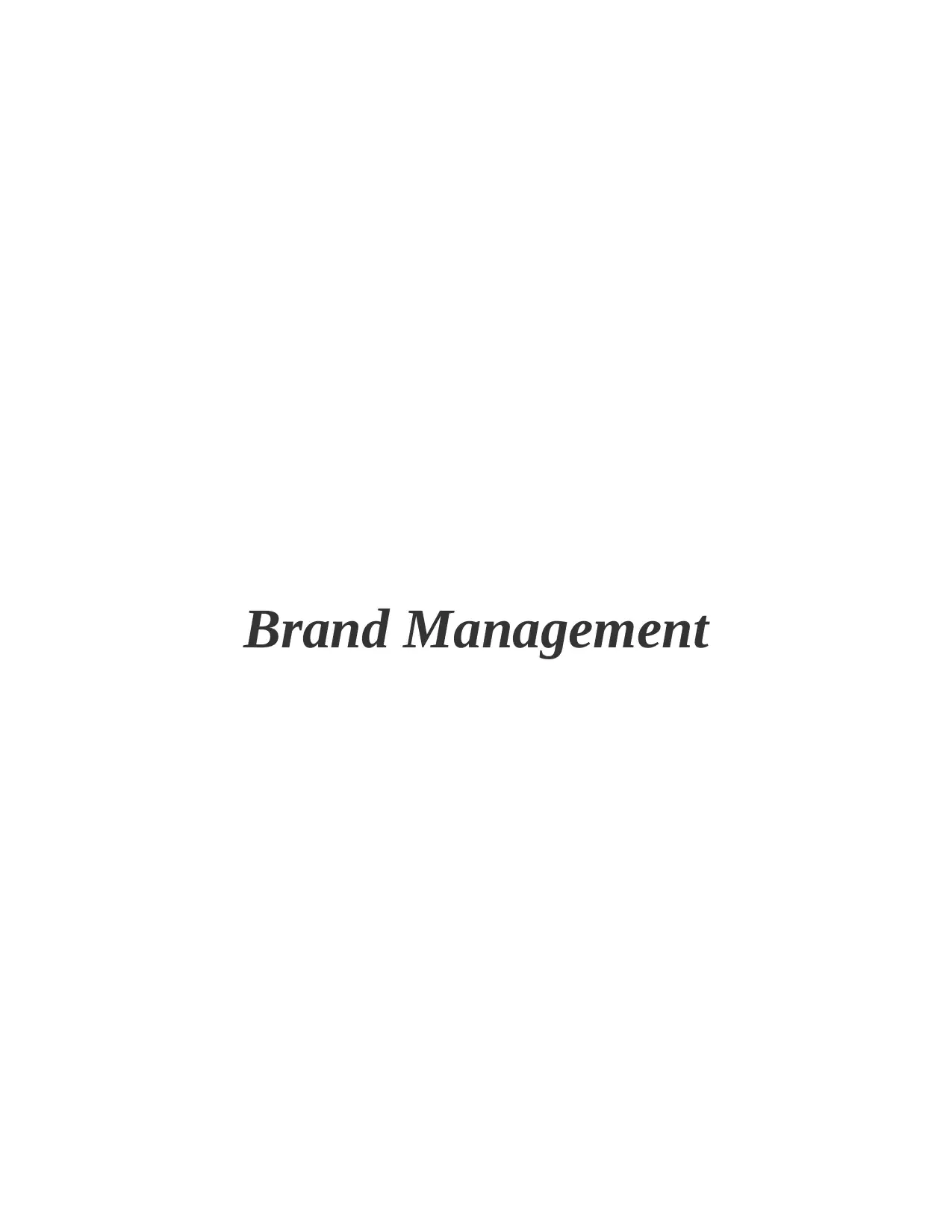
Brand Management
Paraphrase This Document
Need a fresh take? Get an instant paraphrase of this document with our AI Paraphraser
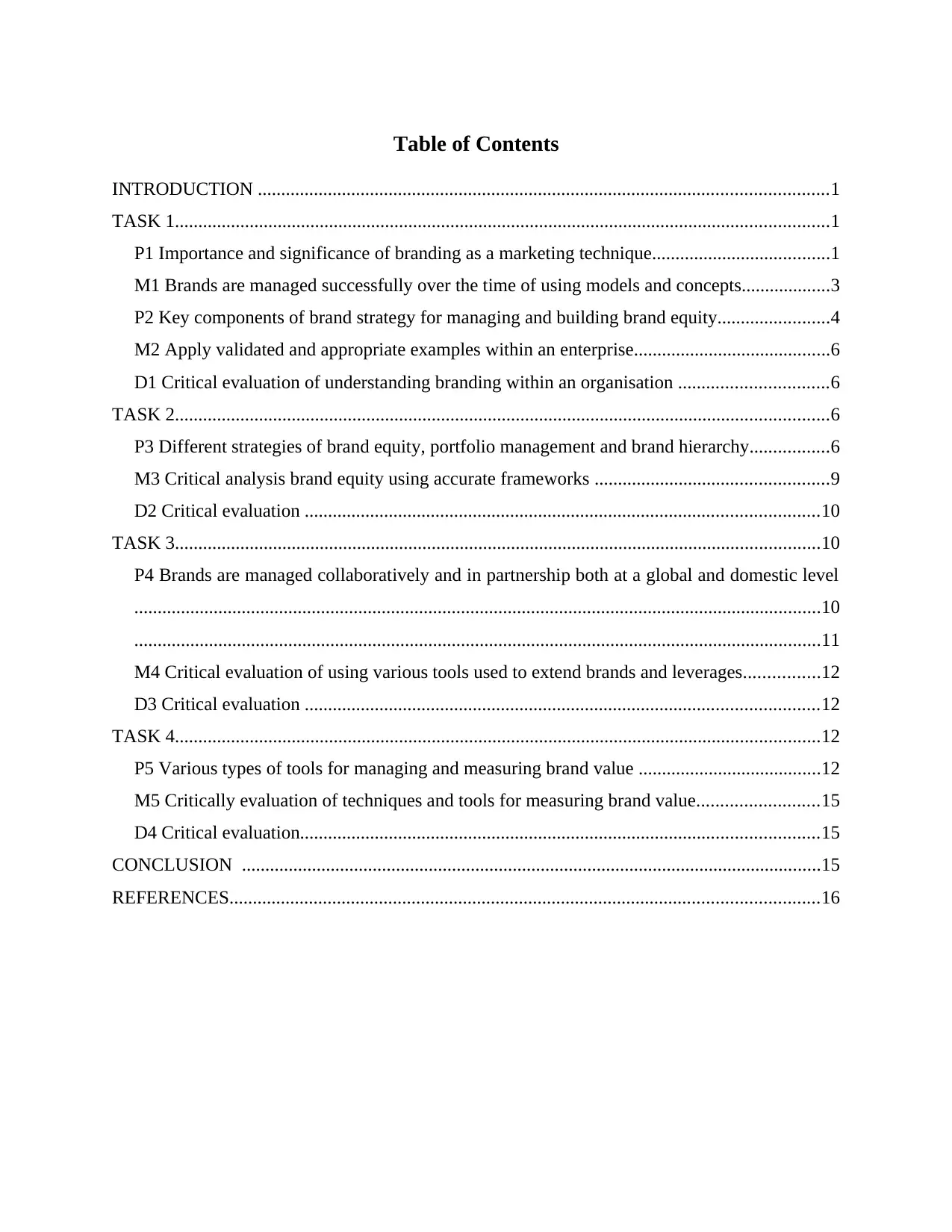
Table of Contents
INTRODUCTION ..........................................................................................................................1
TASK 1............................................................................................................................................1
P1 Importance and significance of branding as a marketing technique......................................1
M1 Brands are managed successfully over the time of using models and concepts...................3
P2 Key components of brand strategy for managing and building brand equity........................4
M2 Apply validated and appropriate examples within an enterprise..........................................6
D1 Critical evaluation of understanding branding within an organisation ................................6
TASK 2............................................................................................................................................6
P3 Different strategies of brand equity, portfolio management and brand hierarchy.................6
M3 Critical analysis brand equity using accurate frameworks ..................................................9
D2 Critical evaluation ..............................................................................................................10
TASK 3..........................................................................................................................................10
P4 Brands are managed collaboratively and in partnership both at a global and domestic level
...................................................................................................................................................10
...................................................................................................................................................11
M4 Critical evaluation of using various tools used to extend brands and leverages................12
D3 Critical evaluation ..............................................................................................................12
TASK 4..........................................................................................................................................12
P5 Various types of tools for managing and measuring brand value .......................................12
M5 Critically evaluation of techniques and tools for measuring brand value..........................15
D4 Critical evaluation...............................................................................................................15
CONCLUSION ............................................................................................................................15
REFERENCES..............................................................................................................................16
INTRODUCTION ..........................................................................................................................1
TASK 1............................................................................................................................................1
P1 Importance and significance of branding as a marketing technique......................................1
M1 Brands are managed successfully over the time of using models and concepts...................3
P2 Key components of brand strategy for managing and building brand equity........................4
M2 Apply validated and appropriate examples within an enterprise..........................................6
D1 Critical evaluation of understanding branding within an organisation ................................6
TASK 2............................................................................................................................................6
P3 Different strategies of brand equity, portfolio management and brand hierarchy.................6
M3 Critical analysis brand equity using accurate frameworks ..................................................9
D2 Critical evaluation ..............................................................................................................10
TASK 3..........................................................................................................................................10
P4 Brands are managed collaboratively and in partnership both at a global and domestic level
...................................................................................................................................................10
...................................................................................................................................................11
M4 Critical evaluation of using various tools used to extend brands and leverages................12
D3 Critical evaluation ..............................................................................................................12
TASK 4..........................................................................................................................................12
P5 Various types of tools for managing and measuring brand value .......................................12
M5 Critically evaluation of techniques and tools for measuring brand value..........................15
D4 Critical evaluation...............................................................................................................15
CONCLUSION ............................................................................................................................15
REFERENCES..............................................................................................................................16
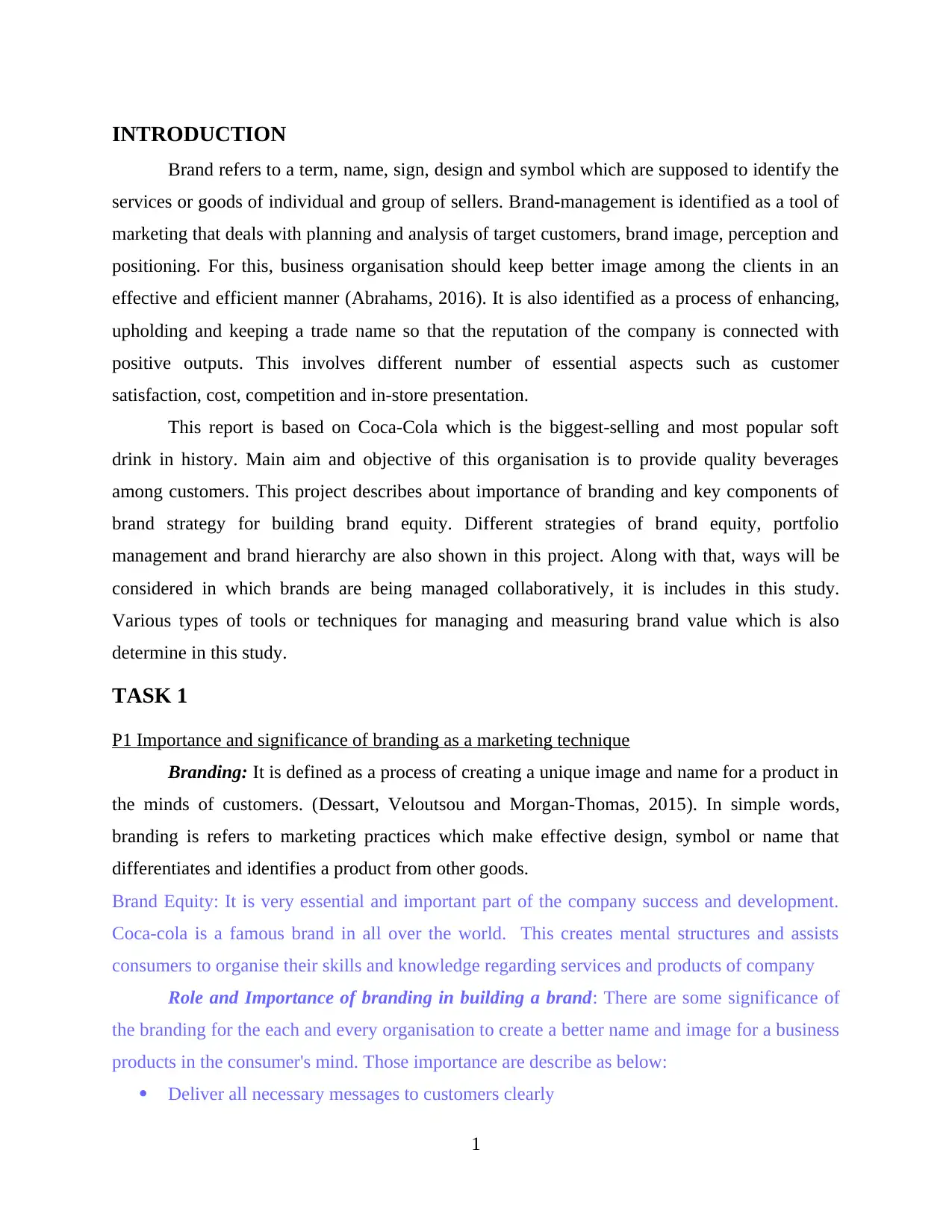
INTRODUCTION
Brand refers to a term, name, sign, design and symbol which are supposed to identify the
services or goods of individual and group of sellers. Brand-management is identified as a tool of
marketing that deals with planning and analysis of target customers, brand image, perception and
positioning. For this, business organisation should keep better image among the clients in an
effective and efficient manner (Abrahams, 2016). It is also identified as a process of enhancing,
upholding and keeping a trade name so that the reputation of the company is connected with
positive outputs. This involves different number of essential aspects such as customer
satisfaction, cost, competition and in-store presentation.
This report is based on Coca-Cola which is the biggest-selling and most popular soft
drink in history. Main aim and objective of this organisation is to provide quality beverages
among customers. This project describes about importance of branding and key components of
brand strategy for building brand equity. Different strategies of brand equity, portfolio
management and brand hierarchy are also shown in this project. Along with that, ways will be
considered in which brands are being managed collaboratively, it is includes in this study.
Various types of tools or techniques for managing and measuring brand value which is also
determine in this study.
TASK 1
P1 Importance and significance of branding as a marketing technique
Branding: It is defined as a process of creating a unique image and name for a product in
the minds of customers. (Dessart, Veloutsou and Morgan-Thomas, 2015). In simple words,
branding is refers to marketing practices which make effective design, symbol or name that
differentiates and identifies a product from other goods.
Brand Equity: It is very essential and important part of the company success and development.
Coca-cola is a famous brand in all over the world. This creates mental structures and assists
consumers to organise their skills and knowledge regarding services and products of company
Role and Importance of branding in building a brand: There are some significance of
the branding for the each and every organisation to create a better name and image for a business
products in the consumer's mind. Those importance are describe as below:
Deliver all necessary messages to customers clearly
1
Brand refers to a term, name, sign, design and symbol which are supposed to identify the
services or goods of individual and group of sellers. Brand-management is identified as a tool of
marketing that deals with planning and analysis of target customers, brand image, perception and
positioning. For this, business organisation should keep better image among the clients in an
effective and efficient manner (Abrahams, 2016). It is also identified as a process of enhancing,
upholding and keeping a trade name so that the reputation of the company is connected with
positive outputs. This involves different number of essential aspects such as customer
satisfaction, cost, competition and in-store presentation.
This report is based on Coca-Cola which is the biggest-selling and most popular soft
drink in history. Main aim and objective of this organisation is to provide quality beverages
among customers. This project describes about importance of branding and key components of
brand strategy for building brand equity. Different strategies of brand equity, portfolio
management and brand hierarchy are also shown in this project. Along with that, ways will be
considered in which brands are being managed collaboratively, it is includes in this study.
Various types of tools or techniques for managing and measuring brand value which is also
determine in this study.
TASK 1
P1 Importance and significance of branding as a marketing technique
Branding: It is defined as a process of creating a unique image and name for a product in
the minds of customers. (Dessart, Veloutsou and Morgan-Thomas, 2015). In simple words,
branding is refers to marketing practices which make effective design, symbol or name that
differentiates and identifies a product from other goods.
Brand Equity: It is very essential and important part of the company success and development.
Coca-cola is a famous brand in all over the world. This creates mental structures and assists
consumers to organise their skills and knowledge regarding services and products of company
Role and Importance of branding in building a brand: There are some significance of
the branding for the each and every organisation to create a better name and image for a business
products in the consumer's mind. Those importance are describe as below:
Deliver all necessary messages to customers clearly
1
⊘ This is a preview!⊘
Do you want full access?
Subscribe today to unlock all pages.

Trusted by 1+ million students worldwide
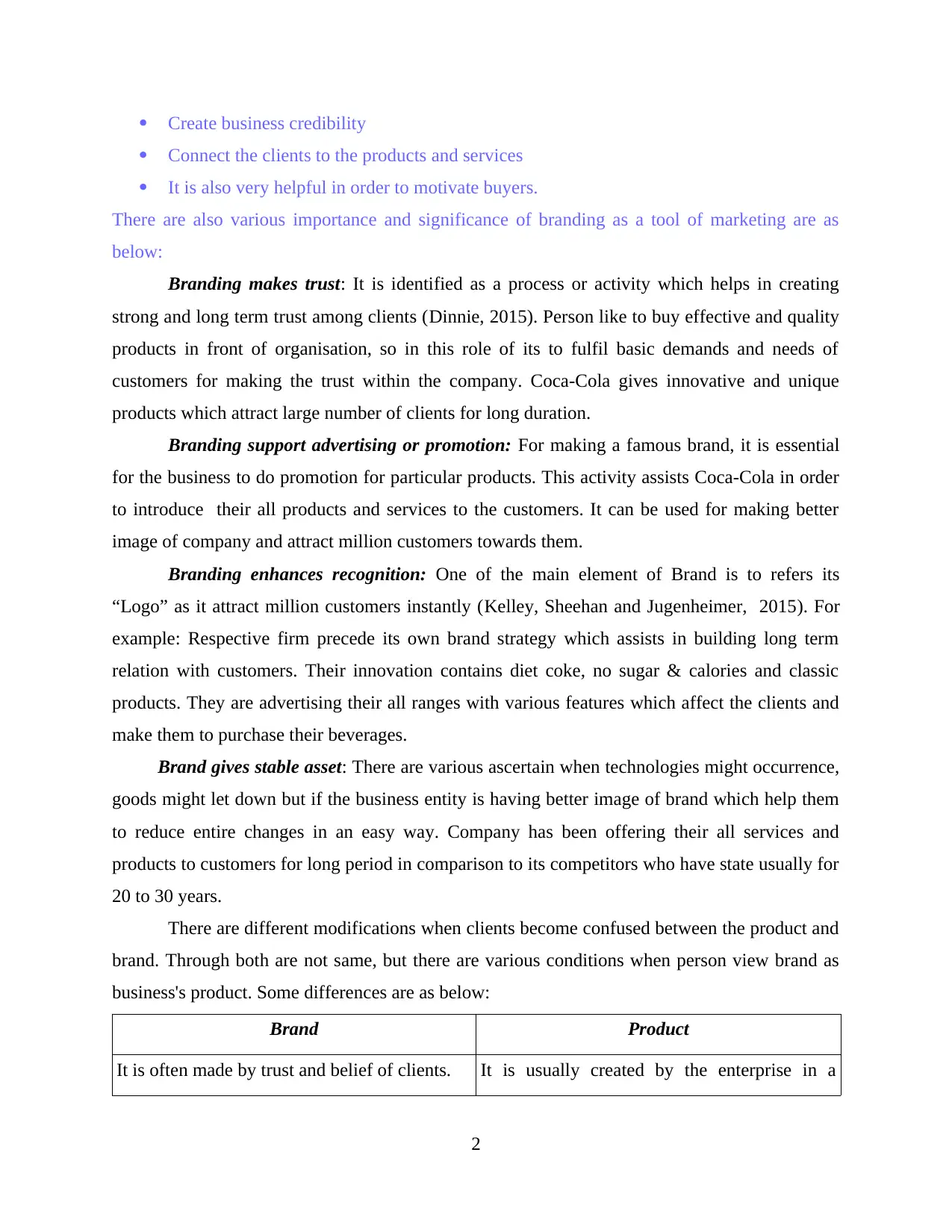
Create business credibility
Connect the clients to the products and services
It is also very helpful in order to motivate buyers.
There are also various importance and significance of branding as a tool of marketing are as
below:
Branding makes trust: It is identified as a process or activity which helps in creating
strong and long term trust among clients (Dinnie, 2015). Person like to buy effective and quality
products in front of organisation, so in this role of its to fulfil basic demands and needs of
customers for making the trust within the company. Coca-Cola gives innovative and unique
products which attract large number of clients for long duration.
Branding support advertising or promotion: For making a famous brand, it is essential
for the business to do promotion for particular products. This activity assists Coca-Cola in order
to introduce their all products and services to the customers. It can be used for making better
image of company and attract million customers towards them.
Branding enhances recognition: One of the main element of Brand is to refers its
“Logo” as it attract million customers instantly (Kelley, Sheehan and Jugenheimer, 2015). For
example: Respective firm precede its own brand strategy which assists in building long term
relation with customers. Their innovation contains diet coke, no sugar & calories and classic
products. They are advertising their all ranges with various features which affect the clients and
make them to purchase their beverages.
Brand gives stable asset: There are various ascertain when technologies might occurrence,
goods might let down but if the business entity is having better image of brand which help them
to reduce entire changes in an easy way. Company has been offering their all services and
products to customers for long period in comparison to its competitors who have state usually for
20 to 30 years.
There are different modifications when clients become confused between the product and
brand. Through both are not same, but there are various conditions when person view brand as
business's product. Some differences are as below:
Brand Product
It is often made by trust and belief of clients. It is usually created by the enterprise in a
2
Connect the clients to the products and services
It is also very helpful in order to motivate buyers.
There are also various importance and significance of branding as a tool of marketing are as
below:
Branding makes trust: It is identified as a process or activity which helps in creating
strong and long term trust among clients (Dinnie, 2015). Person like to buy effective and quality
products in front of organisation, so in this role of its to fulfil basic demands and needs of
customers for making the trust within the company. Coca-Cola gives innovative and unique
products which attract large number of clients for long duration.
Branding support advertising or promotion: For making a famous brand, it is essential
for the business to do promotion for particular products. This activity assists Coca-Cola in order
to introduce their all products and services to the customers. It can be used for making better
image of company and attract million customers towards them.
Branding enhances recognition: One of the main element of Brand is to refers its
“Logo” as it attract million customers instantly (Kelley, Sheehan and Jugenheimer, 2015). For
example: Respective firm precede its own brand strategy which assists in building long term
relation with customers. Their innovation contains diet coke, no sugar & calories and classic
products. They are advertising their all ranges with various features which affect the clients and
make them to purchase their beverages.
Brand gives stable asset: There are various ascertain when technologies might occurrence,
goods might let down but if the business entity is having better image of brand which help them
to reduce entire changes in an easy way. Company has been offering their all services and
products to customers for long period in comparison to its competitors who have state usually for
20 to 30 years.
There are different modifications when clients become confused between the product and
brand. Through both are not same, but there are various conditions when person view brand as
business's product. Some differences are as below:
Brand Product
It is often made by trust and belief of clients. It is usually created by the enterprise in a
2
Paraphrase This Document
Need a fresh take? Get an instant paraphrase of this document with our AI Paraphraser
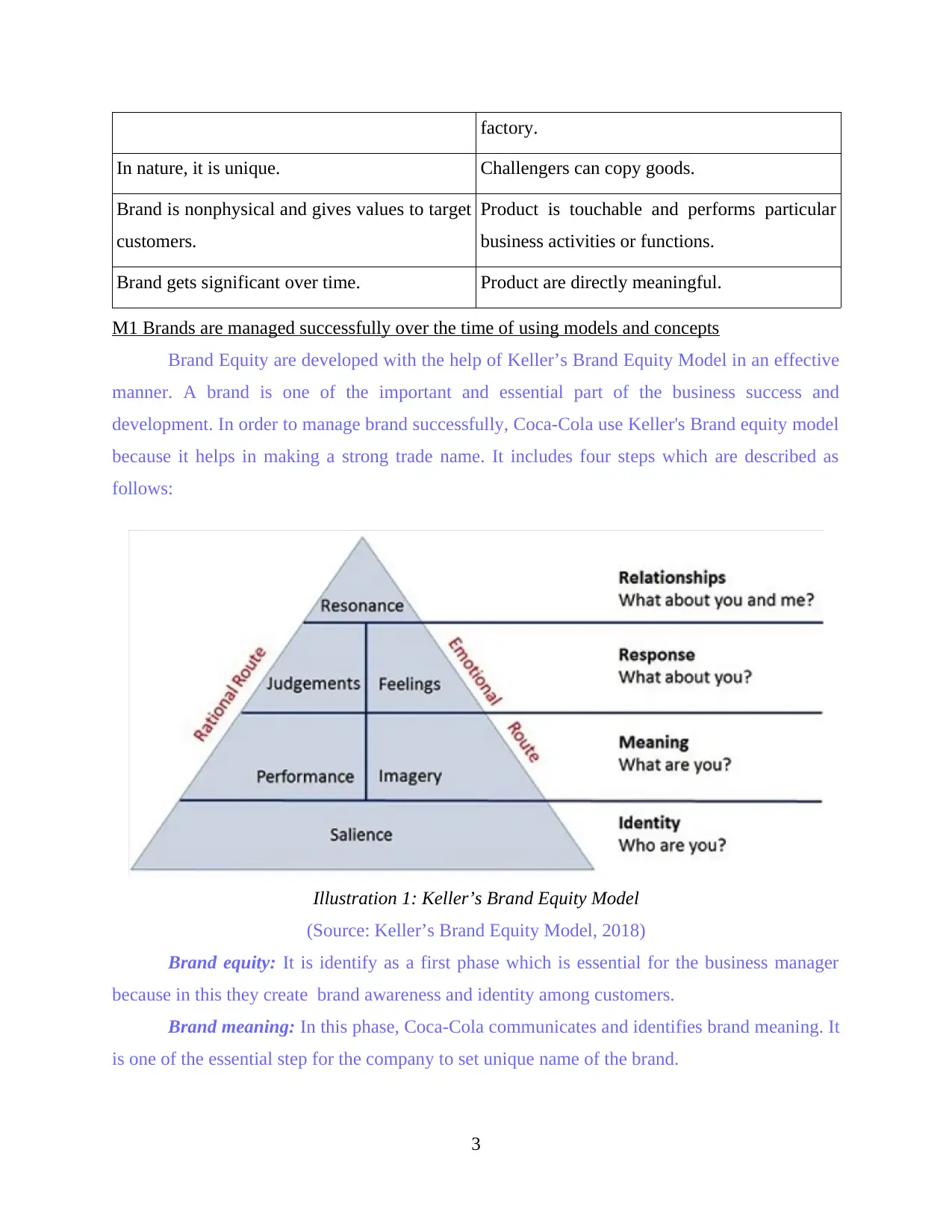
factory.
In nature, it is unique. Challengers can copy goods.
Brand is nonphysical and gives values to target
customers.
Product is touchable and performs particular
business activities or functions.
Brand gets significant over time. Product are directly meaningful.
M1 Brands are managed successfully over the time of using models and concepts
Brand Equity are developed with the help of Keller’s Brand Equity Model in an effective
manner. A brand is one of the important and essential part of the business success and
development. In order to manage brand successfully, Coca-Cola use Keller's Brand equity model
because it helps in making a strong trade name. It includes four steps which are described as
follows:
(Source: Keller’s Brand Equity Model, 2018)
Brand equity: It is identify as a first phase which is essential for the business manager
because in this they create brand awareness and identity among customers.
Brand meaning: In this phase, Coca-Cola communicates and identifies brand meaning. It
is one of the essential step for the company to set unique name of the brand.
3
Illustration 1: Keller’s Brand Equity Model
In nature, it is unique. Challengers can copy goods.
Brand is nonphysical and gives values to target
customers.
Product is touchable and performs particular
business activities or functions.
Brand gets significant over time. Product are directly meaningful.
M1 Brands are managed successfully over the time of using models and concepts
Brand Equity are developed with the help of Keller’s Brand Equity Model in an effective
manner. A brand is one of the important and essential part of the business success and
development. In order to manage brand successfully, Coca-Cola use Keller's Brand equity model
because it helps in making a strong trade name. It includes four steps which are described as
follows:
(Source: Keller’s Brand Equity Model, 2018)
Brand equity: It is identify as a first phase which is essential for the business manager
because in this they create brand awareness and identity among customers.
Brand meaning: In this phase, Coca-Cola communicates and identifies brand meaning. It
is one of the essential step for the company to set unique name of the brand.
3
Illustration 1: Keller’s Brand Equity Model
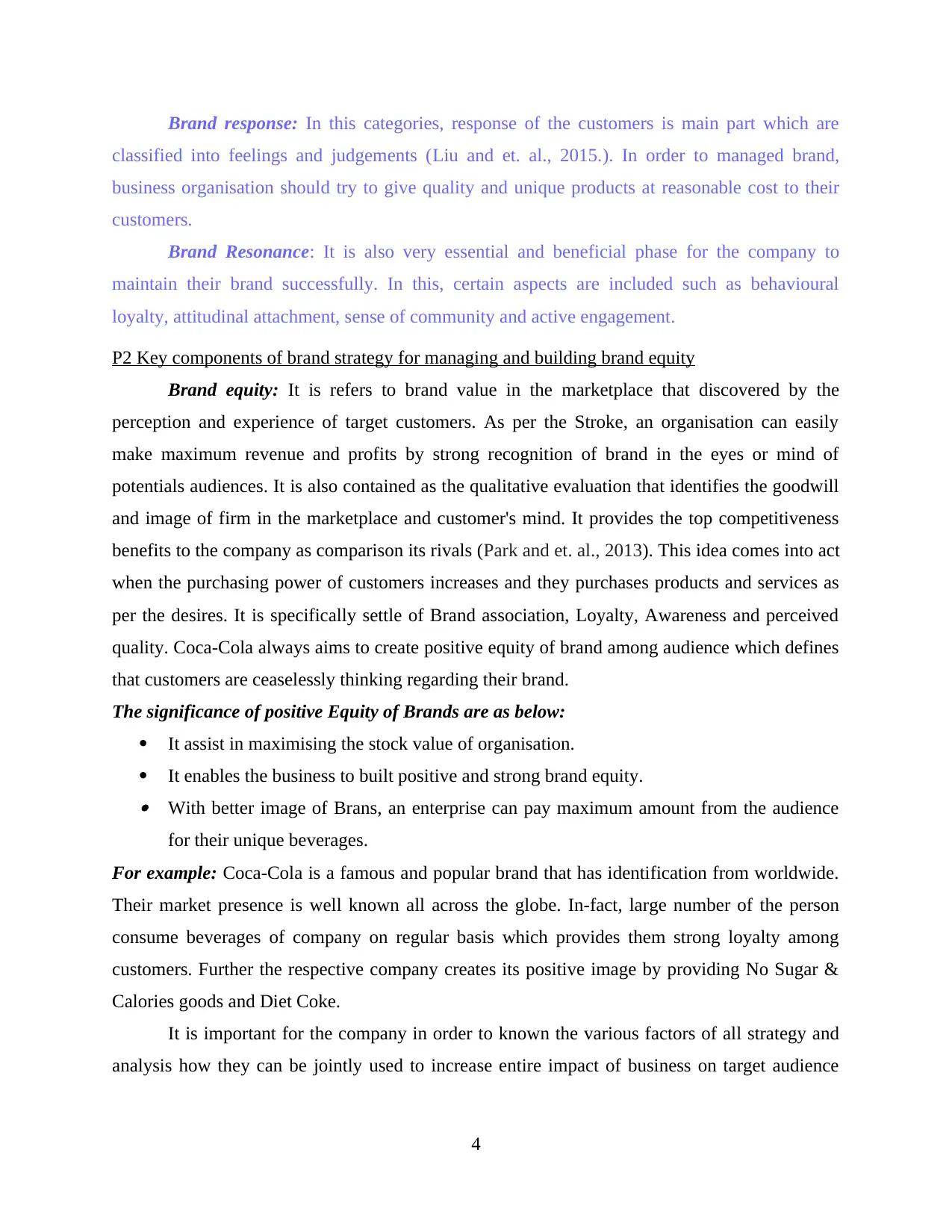
Brand response: In this categories, response of the customers is main part which are
classified into feelings and judgements (Liu and et. al., 2015.). In order to managed brand,
business organisation should try to give quality and unique products at reasonable cost to their
customers.
Brand Resonance: It is also very essential and beneficial phase for the company to
maintain their brand successfully. In this, certain aspects are included such as behavioural
loyalty, attitudinal attachment, sense of community and active engagement.
P2 Key components of brand strategy for managing and building brand equity
Brand equity: It is refers to brand value in the marketplace that discovered by the
perception and experience of target customers. As per the Stroke, an organisation can easily
make maximum revenue and profits by strong recognition of brand in the eyes or mind of
potentials audiences. It is also contained as the qualitative evaluation that identifies the goodwill
and image of firm in the marketplace and customer's mind. It provides the top competitiveness
benefits to the company as comparison its rivals (Park and et. al., 2013). This idea comes into act
when the purchasing power of customers increases and they purchases products and services as
per the desires. It is specifically settle of Brand association, Loyalty, Awareness and perceived
quality. Coca-Cola always aims to create positive equity of brand among audience which defines
that customers are ceaselessly thinking regarding their brand.
The significance of positive Equity of Brands are as below:
It assist in maximising the stock value of organisation.
It enables the business to built positive and strong brand equity. With better image of Brans, an enterprise can pay maximum amount from the audience
for their unique beverages.
For example: Coca-Cola is a famous and popular brand that has identification from worldwide.
Their market presence is well known all across the globe. In-fact, large number of the person
consume beverages of company on regular basis which provides them strong loyalty among
customers. Further the respective company creates its positive image by providing No Sugar &
Calories goods and Diet Coke.
It is important for the company in order to known the various factors of all strategy and
analysis how they can be jointly used to increase entire impact of business on target audience
4
classified into feelings and judgements (Liu and et. al., 2015.). In order to managed brand,
business organisation should try to give quality and unique products at reasonable cost to their
customers.
Brand Resonance: It is also very essential and beneficial phase for the company to
maintain their brand successfully. In this, certain aspects are included such as behavioural
loyalty, attitudinal attachment, sense of community and active engagement.
P2 Key components of brand strategy for managing and building brand equity
Brand equity: It is refers to brand value in the marketplace that discovered by the
perception and experience of target customers. As per the Stroke, an organisation can easily
make maximum revenue and profits by strong recognition of brand in the eyes or mind of
potentials audiences. It is also contained as the qualitative evaluation that identifies the goodwill
and image of firm in the marketplace and customer's mind. It provides the top competitiveness
benefits to the company as comparison its rivals (Park and et. al., 2013). This idea comes into act
when the purchasing power of customers increases and they purchases products and services as
per the desires. It is specifically settle of Brand association, Loyalty, Awareness and perceived
quality. Coca-Cola always aims to create positive equity of brand among audience which defines
that customers are ceaselessly thinking regarding their brand.
The significance of positive Equity of Brands are as below:
It assist in maximising the stock value of organisation.
It enables the business to built positive and strong brand equity. With better image of Brans, an enterprise can pay maximum amount from the audience
for their unique beverages.
For example: Coca-Cola is a famous and popular brand that has identification from worldwide.
Their market presence is well known all across the globe. In-fact, large number of the person
consume beverages of company on regular basis which provides them strong loyalty among
customers. Further the respective company creates its positive image by providing No Sugar &
Calories goods and Diet Coke.
It is important for the company in order to known the various factors of all strategy and
analysis how they can be jointly used to increase entire impact of business on target audience
4
⊘ This is a preview!⊘
Do you want full access?
Subscribe today to unlock all pages.

Trusted by 1+ million students worldwide
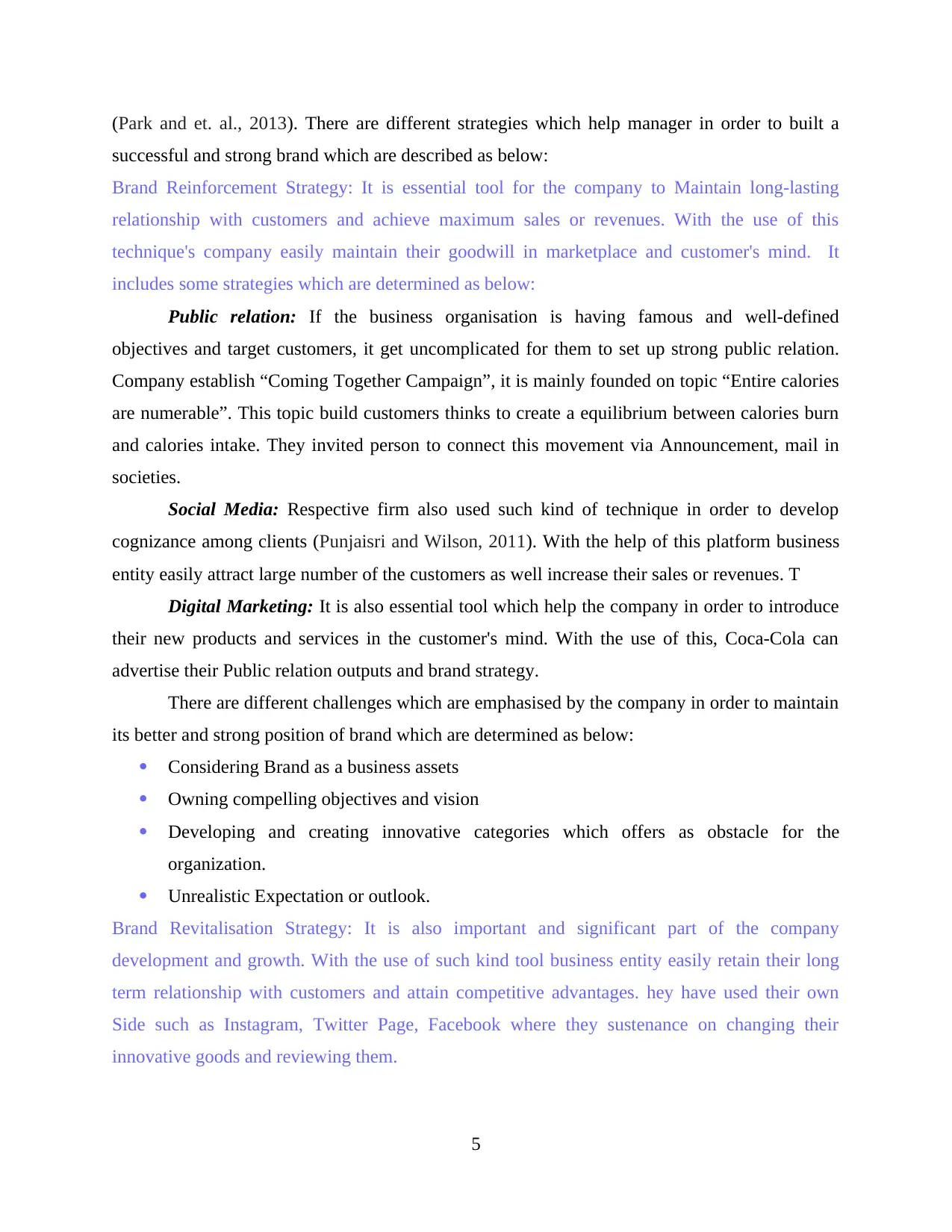
(Park and et. al., 2013). There are different strategies which help manager in order to built a
successful and strong brand which are described as below:
Brand Reinforcement Strategy: It is essential tool for the company to Maintain long-lasting
relationship with customers and achieve maximum sales or revenues. With the use of this
technique's company easily maintain their goodwill in marketplace and customer's mind. It
includes some strategies which are determined as below:
Public relation: If the business organisation is having famous and well-defined
objectives and target customers, it get uncomplicated for them to set up strong public relation.
Company establish “Coming Together Campaign”, it is mainly founded on topic “Entire calories
are numerable”. This topic build customers thinks to create a equilibrium between calories burn
and calories intake. They invited person to connect this movement via Announcement, mail in
societies.
Social Media: Respective firm also used such kind of technique in order to develop
cognizance among clients (Punjaisri and Wilson, 2011). With the help of this platform business
entity easily attract large number of the customers as well increase their sales or revenues. T
Digital Marketing: It is also essential tool which help the company in order to introduce
their new products and services in the customer's mind. With the use of this, Coca-Cola can
advertise their Public relation outputs and brand strategy.
There are different challenges which are emphasised by the company in order to maintain
its better and strong position of brand which are determined as below:
Considering Brand as a business assets
Owning compelling objectives and vision
Developing and creating innovative categories which offers as obstacle for the
organization.
Unrealistic Expectation or outlook.
Brand Revitalisation Strategy: It is also important and significant part of the company
development and growth. With the use of such kind tool business entity easily retain their long
term relationship with customers and attain competitive advantages. hey have used their own
Side such as Instagram, Twitter Page, Facebook where they sustenance on changing their
innovative goods and reviewing them.
5
successful and strong brand which are described as below:
Brand Reinforcement Strategy: It is essential tool for the company to Maintain long-lasting
relationship with customers and achieve maximum sales or revenues. With the use of this
technique's company easily maintain their goodwill in marketplace and customer's mind. It
includes some strategies which are determined as below:
Public relation: If the business organisation is having famous and well-defined
objectives and target customers, it get uncomplicated for them to set up strong public relation.
Company establish “Coming Together Campaign”, it is mainly founded on topic “Entire calories
are numerable”. This topic build customers thinks to create a equilibrium between calories burn
and calories intake. They invited person to connect this movement via Announcement, mail in
societies.
Social Media: Respective firm also used such kind of technique in order to develop
cognizance among clients (Punjaisri and Wilson, 2011). With the help of this platform business
entity easily attract large number of the customers as well increase their sales or revenues. T
Digital Marketing: It is also essential tool which help the company in order to introduce
their new products and services in the customer's mind. With the use of this, Coca-Cola can
advertise their Public relation outputs and brand strategy.
There are different challenges which are emphasised by the company in order to maintain
its better and strong position of brand which are determined as below:
Considering Brand as a business assets
Owning compelling objectives and vision
Developing and creating innovative categories which offers as obstacle for the
organization.
Unrealistic Expectation or outlook.
Brand Revitalisation Strategy: It is also important and significant part of the company
development and growth. With the use of such kind tool business entity easily retain their long
term relationship with customers and attain competitive advantages. hey have used their own
Side such as Instagram, Twitter Page, Facebook where they sustenance on changing their
innovative goods and reviewing them.
5
Paraphrase This Document
Need a fresh take? Get an instant paraphrase of this document with our AI Paraphraser
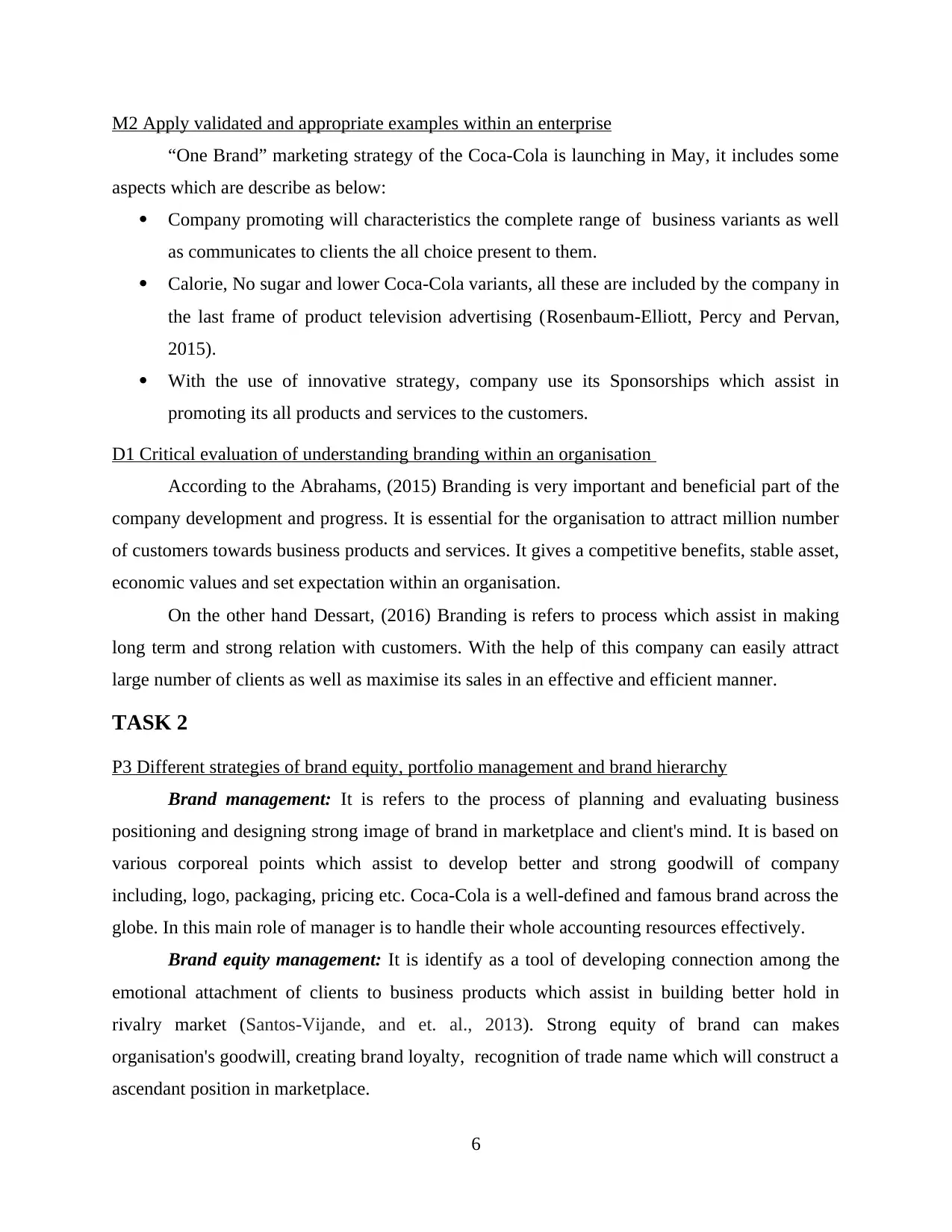
M2 Apply validated and appropriate examples within an enterprise
“One Brand” marketing strategy of the Coca-Cola is launching in May, it includes some
aspects which are describe as below:
Company promoting will characteristics the complete range of business variants as well
as communicates to clients the all choice present to them.
Calorie, No sugar and lower Coca-Cola variants, all these are included by the company in
the last frame of product television advertising (Rosenbaum-Elliott, Percy and Pervan,
2015).
With the use of innovative strategy, company use its Sponsorships which assist in
promoting its all products and services to the customers.
D1 Critical evaluation of understanding branding within an organisation
According to the Abrahams, (2015) Branding is very important and beneficial part of the
company development and progress. It is essential for the organisation to attract million number
of customers towards business products and services. It gives a competitive benefits, stable asset,
economic values and set expectation within an organisation.
On the other hand Dessart, (2016) Branding is refers to process which assist in making
long term and strong relation with customers. With the help of this company can easily attract
large number of clients as well as maximise its sales in an effective and efficient manner.
TASK 2
P3 Different strategies of brand equity, portfolio management and brand hierarchy
Brand management: It is refers to the process of planning and evaluating business
positioning and designing strong image of brand in marketplace and client's mind. It is based on
various corporeal points which assist to develop better and strong goodwill of company
including, logo, packaging, pricing etc. Coca-Cola is a well-defined and famous brand across the
globe. In this main role of manager is to handle their whole accounting resources effectively.
Brand equity management: It is identify as a tool of developing connection among the
emotional attachment of clients to business products which assist in building better hold in
rivalry market (Santos-Vijande, and et. al., 2013). Strong equity of brand can makes
organisation's goodwill, creating brand loyalty, recognition of trade name which will construct a
ascendant position in marketplace.
6
“One Brand” marketing strategy of the Coca-Cola is launching in May, it includes some
aspects which are describe as below:
Company promoting will characteristics the complete range of business variants as well
as communicates to clients the all choice present to them.
Calorie, No sugar and lower Coca-Cola variants, all these are included by the company in
the last frame of product television advertising (Rosenbaum-Elliott, Percy and Pervan,
2015).
With the use of innovative strategy, company use its Sponsorships which assist in
promoting its all products and services to the customers.
D1 Critical evaluation of understanding branding within an organisation
According to the Abrahams, (2015) Branding is very important and beneficial part of the
company development and progress. It is essential for the organisation to attract million number
of customers towards business products and services. It gives a competitive benefits, stable asset,
economic values and set expectation within an organisation.
On the other hand Dessart, (2016) Branding is refers to process which assist in making
long term and strong relation with customers. With the help of this company can easily attract
large number of clients as well as maximise its sales in an effective and efficient manner.
TASK 2
P3 Different strategies of brand equity, portfolio management and brand hierarchy
Brand management: It is refers to the process of planning and evaluating business
positioning and designing strong image of brand in marketplace and client's mind. It is based on
various corporeal points which assist to develop better and strong goodwill of company
including, logo, packaging, pricing etc. Coca-Cola is a well-defined and famous brand across the
globe. In this main role of manager is to handle their whole accounting resources effectively.
Brand equity management: It is identify as a tool of developing connection among the
emotional attachment of clients to business products which assist in building better hold in
rivalry market (Santos-Vijande, and et. al., 2013). Strong equity of brand can makes
organisation's goodwill, creating brand loyalty, recognition of trade name which will construct a
ascendant position in marketplace.
6
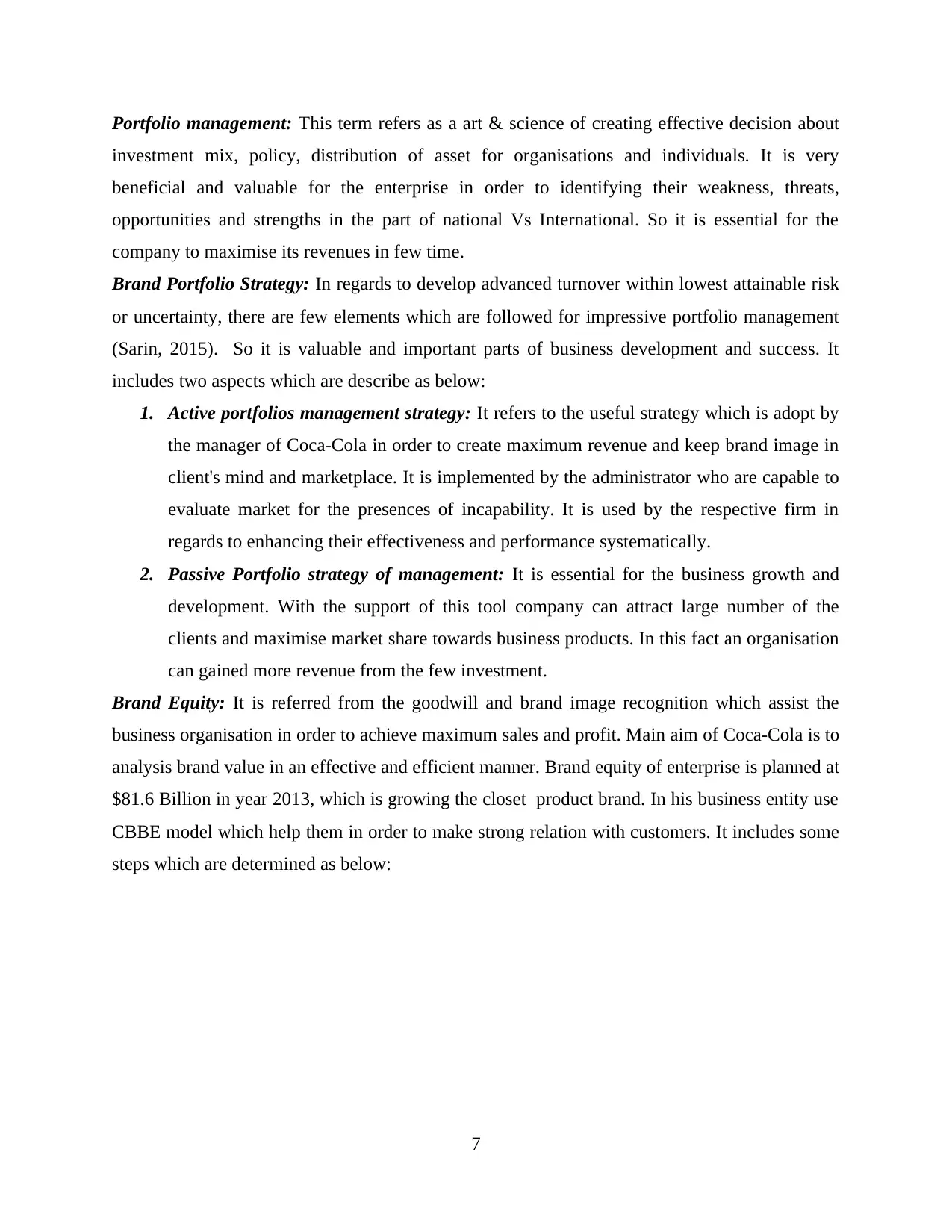
Portfolio management: This term refers as a art & science of creating effective decision about
investment mix, policy, distribution of asset for organisations and individuals. It is very
beneficial and valuable for the enterprise in order to identifying their weakness, threats,
opportunities and strengths in the part of national Vs International. So it is essential for the
company to maximise its revenues in few time.
Brand Portfolio Strategy: In regards to develop advanced turnover within lowest attainable risk
or uncertainty, there are few elements which are followed for impressive portfolio management
(Sarin, 2015). So it is valuable and important parts of business development and success. It
includes two aspects which are describe as below:
1. Active portfolios management strategy: It refers to the useful strategy which is adopt by
the manager of Coca-Cola in order to create maximum revenue and keep brand image in
client's mind and marketplace. It is implemented by the administrator who are capable to
evaluate market for the presences of incapability. It is used by the respective firm in
regards to enhancing their effectiveness and performance systematically.
2. Passive Portfolio strategy of management: It is essential for the business growth and
development. With the support of this tool company can attract large number of the
clients and maximise market share towards business products. In this fact an organisation
can gained more revenue from the few investment.
Brand Equity: It is referred from the goodwill and brand image recognition which assist the
business organisation in order to achieve maximum sales and profit. Main aim of Coca-Cola is to
analysis brand value in an effective and efficient manner. Brand equity of enterprise is planned at
$81.6 Billion in year 2013, which is growing the closet product brand. In his business entity use
CBBE model which help them in order to make strong relation with customers. It includes some
steps which are determined as below:
7
investment mix, policy, distribution of asset for organisations and individuals. It is very
beneficial and valuable for the enterprise in order to identifying their weakness, threats,
opportunities and strengths in the part of national Vs International. So it is essential for the
company to maximise its revenues in few time.
Brand Portfolio Strategy: In regards to develop advanced turnover within lowest attainable risk
or uncertainty, there are few elements which are followed for impressive portfolio management
(Sarin, 2015). So it is valuable and important parts of business development and success. It
includes two aspects which are describe as below:
1. Active portfolios management strategy: It refers to the useful strategy which is adopt by
the manager of Coca-Cola in order to create maximum revenue and keep brand image in
client's mind and marketplace. It is implemented by the administrator who are capable to
evaluate market for the presences of incapability. It is used by the respective firm in
regards to enhancing their effectiveness and performance systematically.
2. Passive Portfolio strategy of management: It is essential for the business growth and
development. With the support of this tool company can attract large number of the
clients and maximise market share towards business products. In this fact an organisation
can gained more revenue from the few investment.
Brand Equity: It is referred from the goodwill and brand image recognition which assist the
business organisation in order to achieve maximum sales and profit. Main aim of Coca-Cola is to
analysis brand value in an effective and efficient manner. Brand equity of enterprise is planned at
$81.6 Billion in year 2013, which is growing the closet product brand. In his business entity use
CBBE model which help them in order to make strong relation with customers. It includes some
steps which are determined as below:
7
⊘ This is a preview!⊘
Do you want full access?
Subscribe today to unlock all pages.

Trusted by 1+ million students worldwide
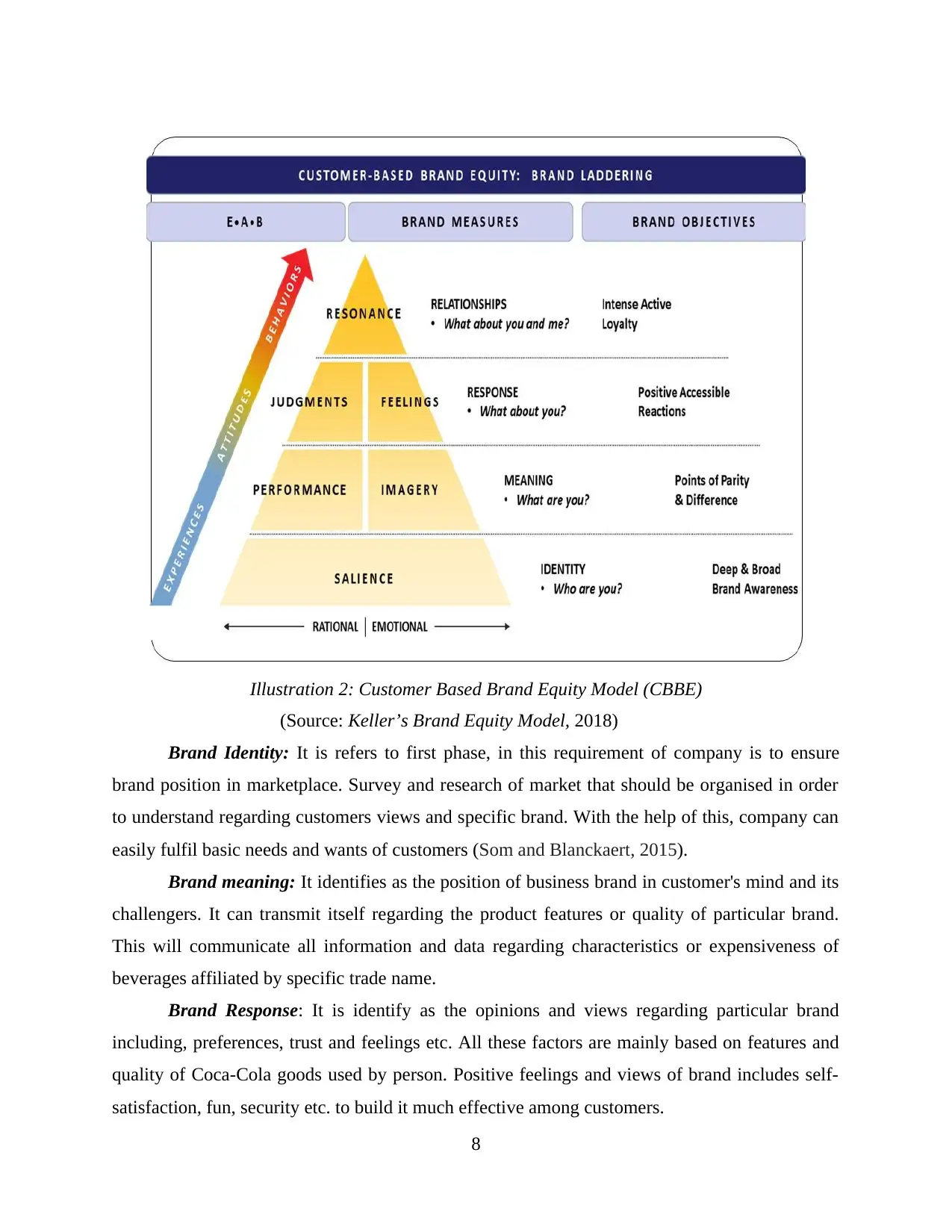
(Source: Keller’s Brand Equity Model, 2018)
Brand Identity: It is refers to first phase, in this requirement of company is to ensure
brand position in marketplace. Survey and research of market that should be organised in order
to understand regarding customers views and specific brand. With the help of this, company can
easily fulfil basic needs and wants of customers (Som and Blanckaert, 2015).
Brand meaning: It identifies as the position of business brand in customer's mind and its
challengers. It can transmit itself regarding the product features or quality of particular brand.
This will communicate all information and data regarding characteristics or expensiveness of
beverages affiliated by specific trade name.
Brand Response: It is identify as the opinions and views regarding particular brand
including, preferences, trust and feelings etc. All these factors are mainly based on features and
quality of Coca-Cola goods used by person. Positive feelings and views of brand includes self-
satisfaction, fun, security etc. to build it much effective among customers.
8
Illustration 2: Customer Based Brand Equity Model (CBBE)
Brand Identity: It is refers to first phase, in this requirement of company is to ensure
brand position in marketplace. Survey and research of market that should be organised in order
to understand regarding customers views and specific brand. With the help of this, company can
easily fulfil basic needs and wants of customers (Som and Blanckaert, 2015).
Brand meaning: It identifies as the position of business brand in customer's mind and its
challengers. It can transmit itself regarding the product features or quality of particular brand.
This will communicate all information and data regarding characteristics or expensiveness of
beverages affiliated by specific trade name.
Brand Response: It is identify as the opinions and views regarding particular brand
including, preferences, trust and feelings etc. All these factors are mainly based on features and
quality of Coca-Cola goods used by person. Positive feelings and views of brand includes self-
satisfaction, fun, security etc. to build it much effective among customers.
8
Illustration 2: Customer Based Brand Equity Model (CBBE)
Paraphrase This Document
Need a fresh take? Get an instant paraphrase of this document with our AI Paraphraser
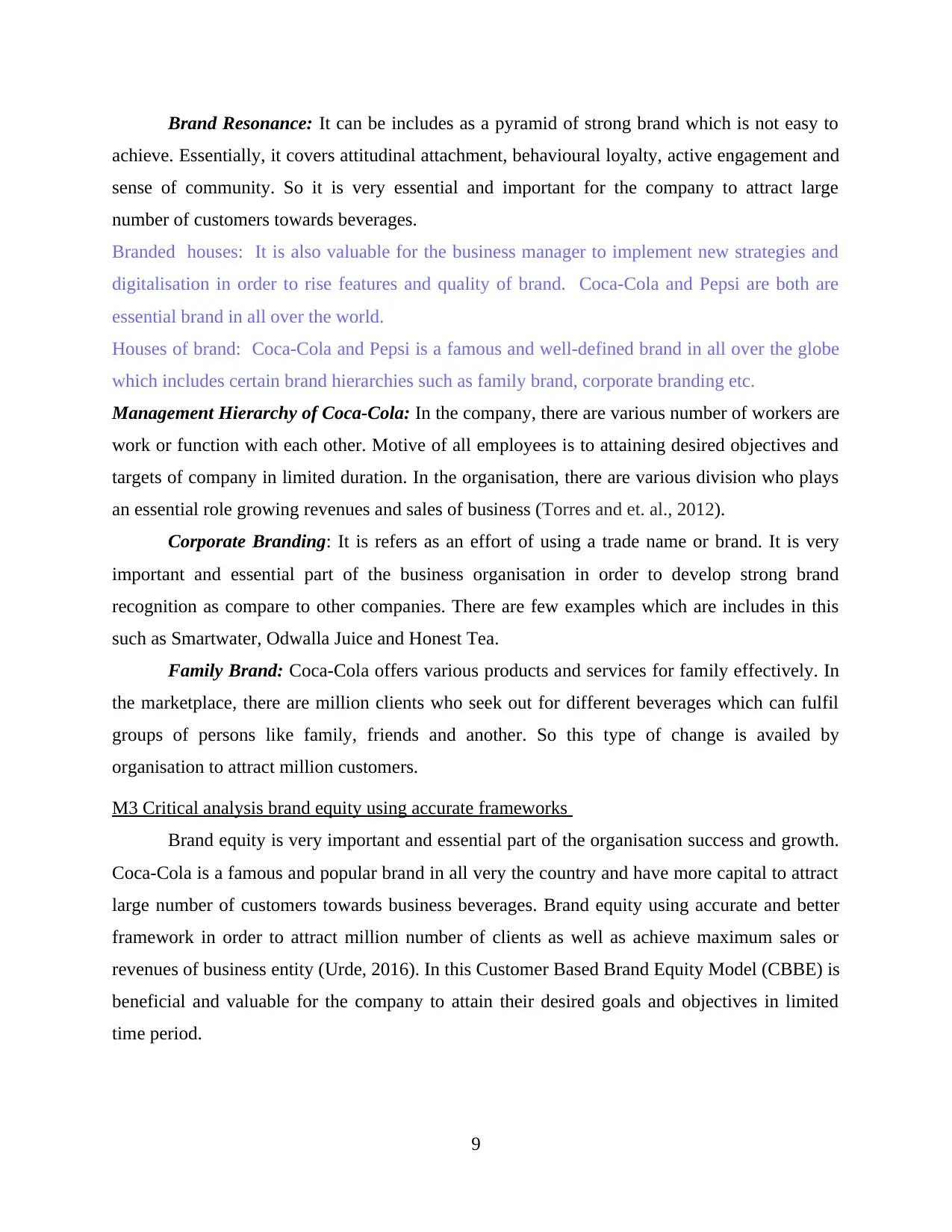
Brand Resonance: It can be includes as a pyramid of strong brand which is not easy to
achieve. Essentially, it covers attitudinal attachment, behavioural loyalty, active engagement and
sense of community. So it is very essential and important for the company to attract large
number of customers towards beverages.
Branded houses: It is also valuable for the business manager to implement new strategies and
digitalisation in order to rise features and quality of brand. Coca-Cola and Pepsi are both are
essential brand in all over the world.
Houses of brand: Coca-Cola and Pepsi is a famous and well-defined brand in all over the globe
which includes certain brand hierarchies such as family brand, corporate branding etc.
Management Hierarchy of Coca-Cola: In the company, there are various number of workers are
work or function with each other. Motive of all employees is to attaining desired objectives and
targets of company in limited duration. In the organisation, there are various division who plays
an essential role growing revenues and sales of business (Torres and et. al., 2012).
Corporate Branding: It is refers as an effort of using a trade name or brand. It is very
important and essential part of the business organisation in order to develop strong brand
recognition as compare to other companies. There are few examples which are includes in this
such as Smartwater, Odwalla Juice and Honest Tea.
Family Brand: Coca-Cola offers various products and services for family effectively. In
the marketplace, there are million clients who seek out for different beverages which can fulfil
groups of persons like family, friends and another. So this type of change is availed by
organisation to attract million customers.
M3 Critical analysis brand equity using accurate frameworks
Brand equity is very important and essential part of the organisation success and growth.
Coca-Cola is a famous and popular brand in all very the country and have more capital to attract
large number of customers towards business beverages. Brand equity using accurate and better
framework in order to attract million number of clients as well as achieve maximum sales or
revenues of business entity (Urde, 2016). In this Customer Based Brand Equity Model (CBBE) is
beneficial and valuable for the company to attain their desired goals and objectives in limited
time period.
9
achieve. Essentially, it covers attitudinal attachment, behavioural loyalty, active engagement and
sense of community. So it is very essential and important for the company to attract large
number of customers towards beverages.
Branded houses: It is also valuable for the business manager to implement new strategies and
digitalisation in order to rise features and quality of brand. Coca-Cola and Pepsi are both are
essential brand in all over the world.
Houses of brand: Coca-Cola and Pepsi is a famous and well-defined brand in all over the globe
which includes certain brand hierarchies such as family brand, corporate branding etc.
Management Hierarchy of Coca-Cola: In the company, there are various number of workers are
work or function with each other. Motive of all employees is to attaining desired objectives and
targets of company in limited duration. In the organisation, there are various division who plays
an essential role growing revenues and sales of business (Torres and et. al., 2012).
Corporate Branding: It is refers as an effort of using a trade name or brand. It is very
important and essential part of the business organisation in order to develop strong brand
recognition as compare to other companies. There are few examples which are includes in this
such as Smartwater, Odwalla Juice and Honest Tea.
Family Brand: Coca-Cola offers various products and services for family effectively. In
the marketplace, there are million clients who seek out for different beverages which can fulfil
groups of persons like family, friends and another. So this type of change is availed by
organisation to attract million customers.
M3 Critical analysis brand equity using accurate frameworks
Brand equity is very important and essential part of the organisation success and growth.
Coca-Cola is a famous and popular brand in all very the country and have more capital to attract
large number of customers towards business beverages. Brand equity using accurate and better
framework in order to attract million number of clients as well as achieve maximum sales or
revenues of business entity (Urde, 2016). In this Customer Based Brand Equity Model (CBBE) is
beneficial and valuable for the company to attain their desired goals and objectives in limited
time period.
9
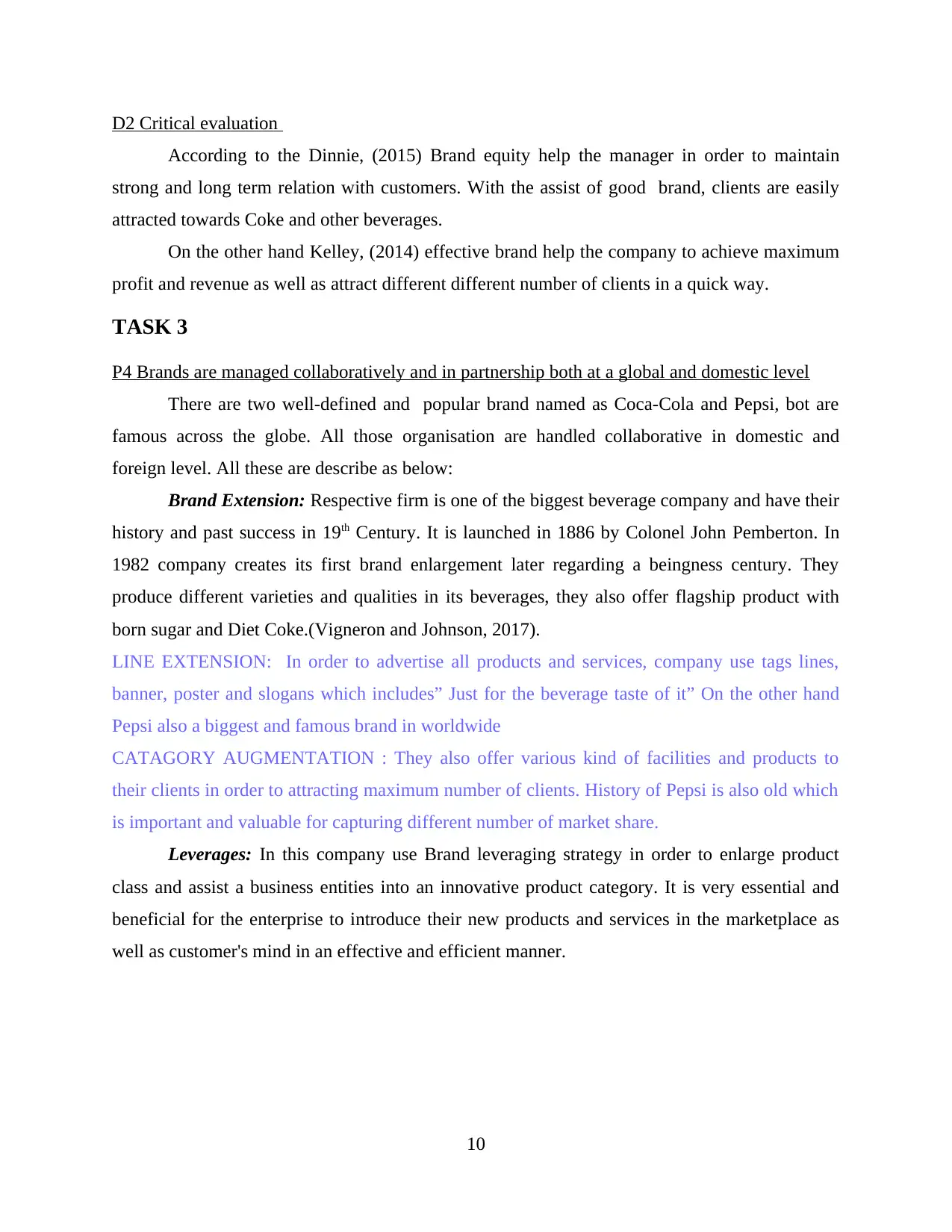
D2 Critical evaluation
According to the Dinnie, (2015) Brand equity help the manager in order to maintain
strong and long term relation with customers. With the assist of good brand, clients are easily
attracted towards Coke and other beverages.
On the other hand Kelley, (2014) effective brand help the company to achieve maximum
profit and revenue as well as attract different different number of clients in a quick way.
TASK 3
P4 Brands are managed collaboratively and in partnership both at a global and domestic level
There are two well-defined and popular brand named as Coca-Cola and Pepsi, bot are
famous across the globe. All those organisation are handled collaborative in domestic and
foreign level. All these are describe as below:
Brand Extension: Respective firm is one of the biggest beverage company and have their
history and past success in 19th Century. It is launched in 1886 by Colonel John Pemberton. In
1982 company creates its first brand enlargement later regarding a beingness century. They
produce different varieties and qualities in its beverages, they also offer flagship product with
born sugar and Diet Coke.(Vigneron and Johnson, 2017).
LINE EXTENSION: In order to advertise all products and services, company use tags lines,
banner, poster and slogans which includes” Just for the beverage taste of it” On the other hand
Pepsi also a biggest and famous brand in worldwide
CATAGORY AUGMENTATION : They also offer various kind of facilities and products to
their clients in order to attracting maximum number of clients. History of Pepsi is also old which
is important and valuable for capturing different number of market share.
Leverages: In this company use Brand leveraging strategy in order to enlarge product
class and assist a business entities into an innovative product category. It is very essential and
beneficial for the enterprise to introduce their new products and services in the marketplace as
well as customer's mind in an effective and efficient manner.
10
According to the Dinnie, (2015) Brand equity help the manager in order to maintain
strong and long term relation with customers. With the assist of good brand, clients are easily
attracted towards Coke and other beverages.
On the other hand Kelley, (2014) effective brand help the company to achieve maximum
profit and revenue as well as attract different different number of clients in a quick way.
TASK 3
P4 Brands are managed collaboratively and in partnership both at a global and domestic level
There are two well-defined and popular brand named as Coca-Cola and Pepsi, bot are
famous across the globe. All those organisation are handled collaborative in domestic and
foreign level. All these are describe as below:
Brand Extension: Respective firm is one of the biggest beverage company and have their
history and past success in 19th Century. It is launched in 1886 by Colonel John Pemberton. In
1982 company creates its first brand enlargement later regarding a beingness century. They
produce different varieties and qualities in its beverages, they also offer flagship product with
born sugar and Diet Coke.(Vigneron and Johnson, 2017).
LINE EXTENSION: In order to advertise all products and services, company use tags lines,
banner, poster and slogans which includes” Just for the beverage taste of it” On the other hand
Pepsi also a biggest and famous brand in worldwide
CATAGORY AUGMENTATION : They also offer various kind of facilities and products to
their clients in order to attracting maximum number of clients. History of Pepsi is also old which
is important and valuable for capturing different number of market share.
Leverages: In this company use Brand leveraging strategy in order to enlarge product
class and assist a business entities into an innovative product category. It is very essential and
beneficial for the enterprise to introduce their new products and services in the marketplace as
well as customer's mind in an effective and efficient manner.
10
⊘ This is a preview!⊘
Do you want full access?
Subscribe today to unlock all pages.

Trusted by 1+ million students worldwide
1 out of 20
Related Documents
Your All-in-One AI-Powered Toolkit for Academic Success.
+13062052269
info@desklib.com
Available 24*7 on WhatsApp / Email
![[object Object]](/_next/static/media/star-bottom.7253800d.svg)
Unlock your academic potential
Copyright © 2020–2025 A2Z Services. All Rights Reserved. Developed and managed by ZUCOL.




